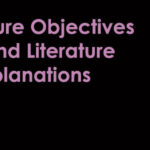Set 4 | Important Languages and Literature of India MCQs
Important Languages and Literature of India MCQs . Indian Languages and Literature are an integral part of Indian Art and Culture, which is extremely beneficial for various examinations such as Civil services, State exams, SSC, Railways, Banking and other One day exams. It provides a great opportunity to gain knowledge about the country’s history in order to excel in these competitive fields. Objectives on Indian Art and Culture for competitive exams.
| MCQs on Languages and Literature of India – Objective Questions and Answers |
Q31. Ayurveda is the Upaveda of ?
[A] Sama Veda
[B] Yajur Veda
[C] Rig Veda
[D] Atharvaveda
View Explanation
Correct Answer is D.
- Ayurveda(Medicine), associated with the Atharvaveda.
Q32. Ghandharvaveda is the Upaveda of ?
[A] Samaveda
[B] Yajur Veda
[C] Rig Veda
[D] Atharvaveda
View Explanation
Correct Answer is A.
- Gandharvaveda(Music and sacred dance), associated with the Samaveda.
Q33. Sthapatyaveda is the Upaveda of ?
[A] Sama Veda
[B] Atharva Veda
[C] Yajur Veda
[D] Rig Veda
View Explanation
Correct Answer is C.
- Sthapatyaveda(Architecture), associated with Yajurveda.
Q34. Dhanurveda is the Upaveda of ?
[A] Yajur Veda
[B] Rig Veda
[C] Atharva Veda
[D] Sama Veda
View Explanation
Correct Answer is B.
- Dhanurveda(Archery), associated with the Rig Veda.
Q35. Limbs of the Vedas are known as ?
[A] Vedangas
[B] Brahmanas
[C] Samhitas
[D] None
View Explanation
Correct Answer is A.
- Limbs of Vedas are also known as Vedangas.
- In order to understand the Vedas, it is necessary to learn the Vedangas. A good deal of literature grew around these subjects.
- These were written in the form of precepts in the sutra style. A precept was called sutra because of its brevity.
- The most famous example of this is Panini’s grammar, Ashtadhyayi, which illustrates the rules of grammer and also throws light on society, economy and culture of those times.
Q36. How many Vedangas are there?
[A] 4
[B] 5
[C] 6
[D] 9
View Explanation
Correct Answer is C.
- The Vedanga are six supplements of the Vedas that developed in ancient times and these are:-
- Shiksha: phonetics, phonology, pronunciation for a vedic recitation.
- Chhandas: prosody, this auxiliary discipline has focussed on the poetic meters.
- Vyakarana: focuses on the rules of grammer and linguistic analysis to establish the exact form of words and sentences to properly express ideas.
- Nirukta: etymology, explanation of words.
- Kalpa: ritual instructions. This field focussed on standardizing procedures for vedic rituals.
- Jyotisha: auspicious time for rituals as per astrology and astronomy.
Q37. In how many ways, Vedic Literature can be classified?
[A] 5
[B] 4
[C] 6
[D] 7
View Explanation
Correct Answer is B.
- The general view of the Vedic literature is that the Vedas consist of four parts – the Samhitas(mantras and benedictions), the Aranyakas(text on rituals, ceremonies, sacrifices and symbolic-sacrifices), the Brahmanas(commentaries on rituals, ceremonies and sacrifices), and the Upanishads(text discussing meditation, philosophy and the spiritual knowledge).
- The Samhitas are sometimes identified as Karma-Kanda(action/ritual-related section).
- The Upanishads are identified as jnana-kanda(knowledge/spirituality-related section).
- The Aranyakas and Brahmanas are variously classified, sometimes as the ceremonial karma-kanda, other times(or parts of them) as the jnana-kanda.
Q38. Mantra section of Vedas are Known as?
[A] Vedangas
[B] Upaveda
[C] Brahmanas
[D] Samhitas
View Explanation
Correct Answer is D.
- The Samhitas contain mantras, prayers, litanies and hymns to God.
- The Samhitas are the most ancient part of the Vedas.
- Hindus believe that the texts were received direct from God by scholars, and that they were then passed on orally for thousands of years.
- In Sanskrit, sam means “correct” and “proper”, and hita means “arranged” or “wholesome”. Thus, samhita may be interpreted as “a structured combination of verses or texts”.
Q39. ‘Kaushitaki and Aitreya’ Brahmanas book are of which Veda?
[A] Rig Veda
[B] Yajur Veda
[C] Sama Veda
[D] None
View Explanation
Correct Answer is A.
- Rig Veda had Kaushitaki and Aitreya.
- These texts describe the 12 days rites, the daily sacrifices conducted in the morning and evening.
- After the four Vedas, a number of works called the Brahmanas were developed. These books gave a detailed explanation of Vedic rituals and instructions and deal with the science of sacrifice.
- Each Veda has its own Brahmana books.
Q40. Brahmanas books were about?
[A] About the predicting future
[B] About explanation of thoughts of Gods
[C] About explanation of Vedic rituals
[D] None
View Explanation
Correct Answer is C.
- Brahmanas books gave a detailed explanation of Vedic rituals.
- The content of the Brahmanas are divided into two main parts:
- Vidhi: It comprises the instructions and warnings related to the performance of particular rituals.
- Arthavada: It comprises the explanatory commentaries in relation to the Mantras and particular rituals.
Related articles:
- Set 1 | Important Languages and Literature of India MCQs
- Set 2 | Important Languages and Literature of India MCQs
- Set 3 | Important Languages and Literature of India MCQs
- Set 5 | Important Languages and Literature of India MCQs
- Set 6 | Important Languages and Literature of India MCQs
- Set 7 | Important Languages and Literature of India MCQs
- Set 8 | Important Languages and Literature of India MCQs


